标签:des style blog http color io os java ar
A method and apparatus for a?atomic?operation?is described. A method comprises receiving a first program unit in a parallel computing environment, the first program unit including a memory update?operation?to be performed atomically, the memory update?operation?having an operand, the operand being of a data-type and of a data size, and translating the first program unit into a second program unit, the second program unit to associate the memory update operation?with a set of one or more low-level instructions upon determining that the data size of the operand is supported by the set of low-level instructions, the set of low-level instructions to ensure atomicity of the memory update?operation.
The invention relates to the field of computer processing. More specifically, the invention relates to a method and apparatus of parallel computation.
Parallel computing of tasks achieves faster execution and/or enables the performance of complex tasks that single processor systems cannot perform. One paradigm for performing parallel computing is shared-memory programming. The OpenMP standard is an agreed upon industry standard for programming shared-memory architectures.
OpenMP provides for synchronization constructs. One of these constructs ensures that memory locations are updated atomically: the?ATOMIC?construct. An?atomic?update?operation?is a sequence of operations or instructions that are non-interruptible to update a memory location. Atomically updating a shared memory location prevents multiple threads of a team from performing the same operation?and/or destroying work done by another thread.
Although OpenMP outlines requirements for constructs and provides guidelines for parallel programming, details for implementing the?ATOMIC?construct are not provided. One method for atomically updating a shared memory location is to acquire locks on the memory location in order to limit modification of the shared memory location to the lock holder. Although this method ensures?atomic updating of the memory location, the updating thread reduces performance with the acquisition and release of locks on the memory location. In addition, performance is reduced since other threads of the updating thread‘s team must wait to update the memory location until the lock on the memory location is released.
Another method to atomically update a memory location that achieves optimal performance is to create platform specific low-level instructions to perform the update. Although vendors can optimize their system with such low-level instructions, the cost to produce the low-level instructions can become a combinatorial explosion. To support such an implementation, vendors would create a number of low-level instructions proportional to the product of the number of data-types, the number of sizes of data-types, and the number of operations to be supported by a single platform. Hence, the cost of creating low-level instructions to support?atomic?updates for numerous operations is prohibitive on a single platform. This prohibitive cost makes a multiple-platform implementation of?atomic?update operations, based solely on platform specific low-level instructions, infeasible.
The invention may best be understood by referring to the following description and accompanying drawings that are used to illustrate embodiments of the invention. In the drawings:
FIG. 1 illustrates an exemplary system?100?comprising processors?102?and?104for translating?atomic?constructs, according to embodiments of the present invention.
FIG. 2 illustrates a data flow diagram for generation of a number of executable program units that include instances of an?atomic?operation?according to one embodiment of the invention.
FIG. 3 is a flow chart for translating an?atomic?operation?according to one embodiment of the invention.
FIG. 4 is a diagram illustrating a program unit being translated into a second program unit according to one embodiment of the invention.
FIG. 5 is a flow chart for performing the translated program unit?405?according to one embodiment of the invention.
FIG. 6A is a diagram illustrating threads encountering the WRAPPER_FXN of the program unit?405?of FIG. 4 according to one embodiment of the invention.
FIG. 6B is a diagram illustrating the thread?603?performing an exemplary operation?of the program unit?405?according to one embodiment of the invention.
FIG. 6C is a diagram illustrating the thread?603?determining atomicity of the memory update?operation?according to one embodiment of the invention.
FIG. 6D is a diagram illustrating the thread?605?performing the loop of the program unit?409?according to one embodiment of the invention.
In the following description, numerous specific details are set forth to provide a thorough understanding of the invention. However, it is understood that the invention may be practiced without these specific details. In other instances, well-known circuits, structures and techniques have not been shown in detail in order not to obscure the invention.
FIG. 1 illustrates an exemplary system?100?comprising processors?102?and?104for translating?atomic?constructs, according to embodiments of the present invention. Although described in the context of system?100, the present invention may be implemented in any suitable computer system comprising any suitable one or more integrated circuits.
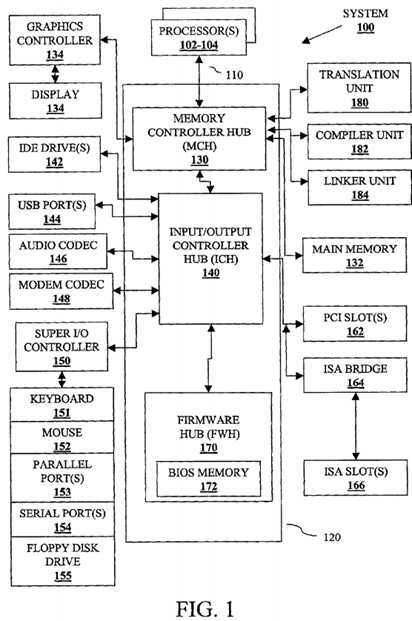
As illustrated in FIG. 1, computer system?100?comprises processor?102?and processor?104. Computer system?100?also includes processor bus?110, and chipset?120. Processors?102?and?104?and chipset?120?are coupled to processor bus?110. Processors?102?and?104?may each comprise any suitable processor architecture and for one embodiment comprise an Intel? Architecture used, for example, in the Pentium? family of processors available from Intel? Corporation of Santa Clara, Calif. Computer system?100?for other embodiments may comprise one, three, or more processors any of which may execute a set of instructions that are in accordance with embodiments of the present invention.
Chipset?120?for one embodiment comprises memory controller hub (MCH)?130, input/output (I/O) controller hub (ICH)?140, and firmware hub (FWH)?170. MCH130, ICH?140, and FWH?170?may each comprise any suitable circuitry and for one embodiment is each formed as a separate integrated circuit chip. Chipset120?for other embodiments may comprise any suitable one or more integrated circuit devices.
MCH?130?may comprise any suitable interface controllers to provide for any suitable communication link to processor bus?110?and/or to any suitable device or component in communication with MCH?130. MCH?130?for one embodiment provides suitable arbitration, buffering, and coherency management for each interface.
MCH?130?is coupled to processor bus?110?and provides an interface to processors?102?and?104?over processor bus?110. Processor?102?and/or processor?104?may alternatively be combined with MCH?130?to form a single chip. MCH?130?for one embodiment also provides an interface to a main memory132?and a graphics controller?134?each coupled to MCH?130. Main memory?132stores data and/or instructions, for example, for computer system?100?and may comprise any suitable memory, such as a dynamic random access memory (DRAM) for example. Graphics controller?134?controls the display of information on a suitable display?136, such as a cathode ray tube (CRT) or liquid crystal display (LCD) for example, coupled to graphics controller?134. MCH?130?for one embodiment interfaces with graphics controller?134?through an accelerated graphics port (AGP). Graphics controller?134?for one embodiment may alternatively be combined with MCH?130?to form a single chip.
MCH?130?is also coupled to ICH?140?to provide access to ICH?140?through a hub interface. ICH?140?provides an interface to I/O devices or peripheral components for computer system?100. ICH?140?may comprise any suitable interface controllers to provide for any suitable communication link to MCH?130?and/or to any suitable device or component in communication with ICH?140. ICH?140?for one embodiment provides suitable arbitration and buffering for each interface.
For one embodiment, ICH?140?provides an interface to one or more suitable integrated drive electronics (IDE) drives?142, such as a hard disk drive (HDD) or compact disc read only memory (CD ROM) drive for example, to store data and/or instructions for example, one or more suitable universal serial bus (USB) devices through one or more USB ports?144, an audio coder/decoder (codec)146, and a modem codec?148. ICH?140?for one embodiment also provides an interface through a super I/O controller?150?to a keyboard?151, a mouse?152, one or more suitable devices, such as a printer for example, through one or more parallel ports?153, one or more suitable devices through one or more serial ports?154, and a floppy disk drive?155. ICH?140?for one embodiment further provides an interface to one or more suitable peripheral component interconnect (PCI) devices coupled to ICH?140?through one or more PCI slots?162?on a PCI bus and an interface to one or more suitable industry standard architecture (ISA) devices coupled to ICH?140?by the PCI bus through an ISA bridge?164. ISA bridge?164?interfaces with one or more ISA devices through one or more ISA slots?166?on an ISA bus.
ICH?140?is also coupled to FWH?170?to provide an interface to FWH?170. FWH170?may comprise any suitable interface controller to provide for any suitable communication link to ICH?140. FWH?170?for one embodiment may share at least a portion of the interface between ICH?140?and super I/O controller?150. FWH?170?comprises a basic input/output system (BIOS) memory?172?to store suitable system and/or video BIOS software. BIOS memory?172?may comprise any suitable non-volatile memory, such as a flash memory for example.
Additionally, computer system?100?includes translation unit?180, compiler unit182?and linker unit?184. In an embodiment, translation unit?180, compiler unit?182and linker unit?184?can be processes or tasks that can reside within main memory?132?and/or processors?102?and?104?and can be executed within processors?102?and?104. However, embodiments of the present invention are not so limited, as translation unit?180, compiler unit?182?and linker unit?184?can be different types of hardware (such as digital logic) executing the processing described herein (which is described in more detail below).
Accordingly, computer system?100?includes a machine-readable medium on which is stored a set of instructions (i.e., software) embodying any one, or all, of the methodologies to be described below. For example, software can reside, completely or at least partially, within main memory?132?and/or within processors102/104. For the purposes of this specification, the term "machine-readable medium" shall be taken to include any mechanism that provides (i.e., stores and/or transmits) information in a form readable by a machine (e.g., a computer). For example, a machine-readable medium includes read only memory (ROM); random access memory (RAM); magnetic disk storage media; optical storage media; flash memory devices; electrical, optical, acoustical or other form of propagated signals (e.g., carrier waves, infrared signals, digital signals, etc.); etc.
FIG. 2 illustrates a data flow diagram for generation of a number of executable program units that include instances of a?atomic?operation?according to one embodiment of the invention. As shown, program unit(s)?202?is input into translation unit?180. In an embodiment, there can be one to a number of such program units input into translation unit?180. Examples of a program unit include a program or a module, subroutine or function within a given program. In one embodiment, program unit(s)?202?are source code. The types of source code may include, but are not limited to, C, C++, Fortran, Java, Pascal, etc. However, embodiments of the present invention are not limited to program unit(s)?202being written at the source code level. In other embodiments, such units can be at other levels, such as assembly code. Moreover, executable program unit(s)210?that are output from linker unit?184?(which is described in more detail below) can be executed in a multi-processor parallel computing environment.
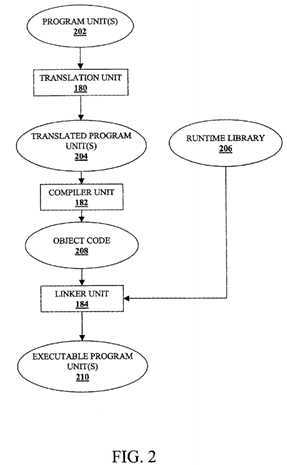
In an embodiment, translation unit?180?performs a source-to-source code level transformation of program unit(s)?202?to generate translated program unit(s)204. However, embodiments of the present invention are not so limited. For example, in another embodiment, translation unit?180?could perform a source-to-assembly code level or source-to-object code level transformation of program unit(s)?202.
Compiler unit?182?receives translated program units?204?and generates object code?208. Compiler unit?182?can be different compilers for different operating systems and/or different hardware. In an embodiment, the compilation of translated program unit(s)?204?is based on the OpenMP standard.
Linker unit?184?receives object code?208?and runtime library?206?and generates executable code?210. Runtime library?206?can include one to a number of different functions or routines that are incorporated into the object code?208. In one embodiment, executable code?210?that is output from linker unit?184?can be executed in a multi-processor parallel computing environment. Additionally, executable program unit(s)?210?can be executed across a number of different operating system platforms, including, but not limited to, different versions of UNIX, Microsoft Windows?, real time operating systems such as VxWorks?, etc.
FIG. 3 is a flow chart for translating an?atomic?operation?according to one embodiment of the invention. An?atomic?operation?protects against races when updating a shared memory location. At block?301, the translation unit?180receives a program unit(s). At block?303, the translation unit?180?encounters anatomic?operation. At block?307, the translation unit?180?determines if the?atomic operation?is supported by a low-level instruction. If the?atomic?operation?is supported by a low-level instruction(s), then at block?309?the translation unit?180translates the?atomic?operation?into an implementation of the low-level instruction(s). For example, the low-level instruction(s) may be implemented as a routine in the runtime library?206.
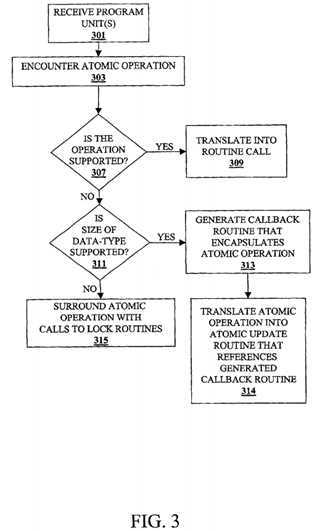
The reference at block?307?to determining if an?operation?is supported by a low-level instruction refers to determining if a low-level instruction(s) can perform the operator on the data-type(s) and data size(s) corresponding to the?atomic operation. For example, assume the?operation?is an addition of two 4-byte integers. This?operation?is supported if a low-level instruction(s) (e.g., a processor instruction(s) in assembly code) that can atomically perform an addition of 4-byte integers (for example, a 4-byte fetch-and-add instruction) resides on the system?100.
If the?atomic?operation?is not supported by a low-level instruction(s), then at block?311?the translation unit?180?determines if the size of the data-type being updated by the?atomic?operation?is supported by a low-level instruction(s) that ensures atomicity. If the size of the data-type is supported by such an instruction(s), then at block?313, the translation unit?180generates a callback routine that encapsulates the?atomic?operation. At block?314, the translation unit?180?translates the atomic?operation?by replacing it with a call to an?atomic?update routine in runtime library?206. The call to the?atomic?update routine has the address of the callback routine described at block?314?as one of the?atomic?update routine‘s arguments. The atomic?update routine causes the memory update?operation?to be performed atomically by enclosing a call to the callback routine with an implementation of the low-level instruction(s) that ensures atomicity. Such instructions can include a compare-and-swap (CAS) instruction, a test-and-set (TAS) instruction, etc.
If the translation unit?180?determines at block?311?that the size of the data-type corresponding to the?atomic?operation?is not supported by such a low-level instruction(s), then the translation unit?180?surrounds the?atomic?operation?with calls to lock routines (e.g., a call to a lock acquisition routine and a call to a lock release routine) in the runtime library?206.
In one embodiment of the invention, the translation unit?180?replaces the?atomic?operation?with a call to a routine or function. In various embodiments of the invention, the translation unit?180?inlines instructions instead of inserting a call to a routine, generates assembly code instead of source code, etc.
In an alternative embodiment of the invention, the compiler unit?182?generates intermediate code for the?atomic?operation.
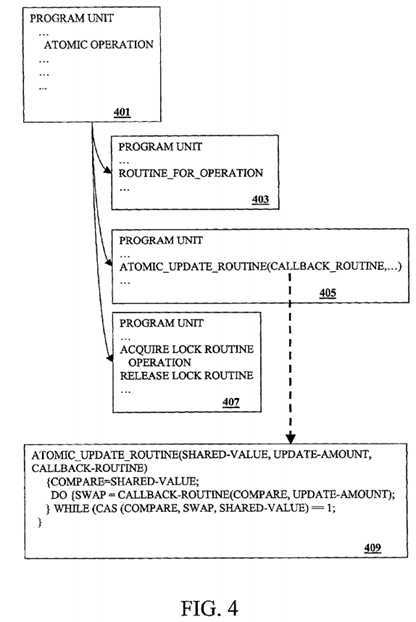
FIG. 4 is a diagram illustrating a program unit being translated into a second program unit according to one embodiment of the invention. FIG. 4 will be described with reference to FIG.?3. In FIG. 4, a program unit?401?includes an?atomic?operation. Program units?403,?405, and?407?are examples of possible translations of the program unit?401. An example of the?atomic operation?illustrated in the program unit?401?can have the following form:
shared-value=memory-update-operation(shared-value, update-amount);
The program unit?403?is an example translation of the program unit?401?in accordance with block?309?in FIG.?3. The program unit?403?includes a call to a routine that implements a low-level instruction(s) that supports the?atomic?operation indicated in the program unit?401. For example, if the update-amount in the exemplary?atomic?operation?shown above is "1", then the ROUTINE_FOR_OPERATION may take the form of an?atomic?fetch-and-add of the shared-value by 1. Another example form of the ROUTINE_FOR_OPERATION could be a "LOCK add shared-value, update-amount" bus lock add instruction.
The program unit?405?is an example translation of the program unit?401?in accordance with blocks?313?and?314?of FIG.?3. The program unit?405?includes an?atomic?update routine as described in block?314. The?atomic?update routine call in the program unit?405?can have the following exemplary form:
atomic-update-routine(shared-value, update-amount, callback-routine);
A program unit?409?is an example of the?atomic-update-routine called in the program unit?405. The?atomic?update routine illustrated in the program unit?409?includes a callback routine as described in block?313?of FIG.?3. An example of the callback routine can be the following:
callback-routine(shared-value, update-amount)
{new-shared-value=memory-update-operation(shared-value, update-amount); return(new-shared-value);}
The callback routine encapsulates the memory update?operation?so that it can be called from the?atomic?update routine.
The implementation of the?atomic?update routine illustrated in the program unit?409?utilizes a CAS instruction to ensure atomicity of the?atomic?operation. The CAS instruction can be defined as follows:
CAS (compare, swap, lock)
{if (compare==lock) then {lock=swap; return 0;} else {compare=lock; return 1;}}
Various embodiments of the described invention can be implemented with other low-level instructions to ensure atomicity.
The program unit?407?is an example translation of the program unit?401?in accordance with block?315?of FIG.?3. The program unit?407?includes a call to a lock-acquire routine and a call to a lock-release routine that surround the memory update?operation. The lock routines in the program unit?407?are used to lock the shared memory location in order to update it with the result of the memory update?operation. Locking the shared memory location prevents the shared memory location from being modified by a second thread while the memory update?operation?is being performed by a first thread. The lock routines can be optimized for portability by implementing separate lock routines for each supported platform with low-level instruction(s). The low-level instruction(s) can be fetch-and-add, bus lock instructions, TAS, etc. An alternative embodiment of the invention may implement platform independent lock routines with higher level instructions.
FIG. 5 is a flow chart for performing the translated program unit?409?according to one embodiment of the invention. FIGS. 6A-6D are diagrams illustrating threads performing the program unit?409?according to one embodiment of the invention. FIG. 5 will be described with reference to FIGS. 6A-6D and FIG.?4. At block?501, a thread of a team arrives at the ATOMIC_UPDATE_ROUTINE of the program unit?405. At block?503, the thread loads the shared-value from a shared memory location to be updated into a memory location that has been allocated to the thread ("compare memory location").
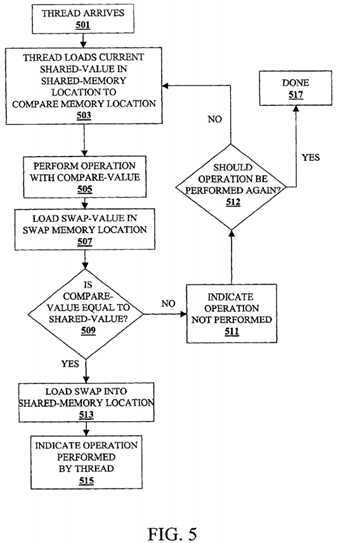
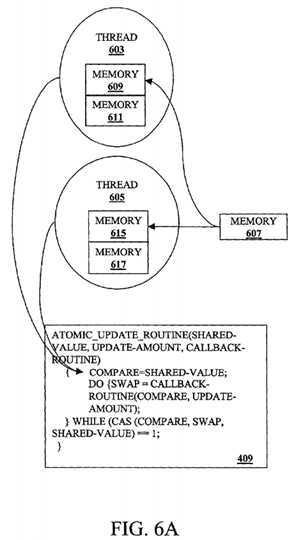
FIG. 6A is a diagram illustrating threads performing the first line of the?atomic?update routine in the program unit?409?of FIG. 4 according to one embodiment of the invention. In FIG. 6A, threads?603?and?605?arrive at the following line of the example ATOMIC_UPDATE_ROUTINE:
compare=shared-value;
In accordance with this line, the thread?603?loads the shared-value of a shared memory location?607?into a memory location609?allocated to the thread?603. Also in response to this line, the thread?605?loads the shared-value of the shared memory location?607?into a memory location?615?that has been allocated to the thread?605.
Returning to FIG. 5 at block?505, the thread performs the memory update?operation?with the compare-value. At block?507, the thread loads the result of the memory update?operation?into a second memory location that is allocated to the thread ("swap memory location") in accordance with the following line of the program unit?409:
swap=callback-routine (compare, update-amount);
FIG. 6B is a diagram illustrating the threads?603?and?605?arriving at the callback routine in the program unit?409?according to one embodiment of the invention. In FIG. 6B, the threads?603?and?605?arrive at the callback routine of the program unit409. Both threads?603?and?605?perform a callback routine, such as the previous example of a callback routine. The threads603?and?605?assign the result of the memory update?operation?to a new shared-value and load the new shared value into memory locations?611?and?617, respectively.


Returning to FIG. 5 at block?509, the thread determines if the shared-value in the shared memory location is equal to the compare value loaded into the compare memory location. If these values are not equal, then at block?511?the thread indicates that the?atomic?operation?has not been performed (e.g., sets an execute bit to false). At block?512, it is determined if the?atomic?operation?is to be attempted again. If the thread is not to attempt the?atomic?operation?again, then at block?517?the thread is done. If the thread is to attempt the?atomic?operation?again, then control flows from block?512?to block?503. If at block?509?the compare value and the shared-value are equal, then the shared-value has not been modified and the thread loads the swap value from the swap memory location into the shared memory location at block?513. At block515?the thread indicates that it has performed the?atomic?operation?(e.g., sets an execution bit to true).
FIG. 6C is a diagram illustrating the thread?603?updating the shared memory location?607?according to one embodiment of the invention. In FIG. 6C, the thread?605?performs the CAS instruction of the program unit?409?to ensure atomicity of the memory update?operation. In accordance with the example of the CAS instruction described above, the thread?603determines if the shared-value in the shared memory location?607?is equal to the compare value in the memory location?609. If the values are equal, then atomicity for the memory update?operation?has not been violated and the thread?603?loads the swap value from the memory location?611?into the shared memory location?607. When the thread?605?performs the exemplary CAS instruction of the program unit?409, the shared-value and the compare value are not equal because the thread?603?has updated the shared memory location?607?with the thread‘s?603?swap value. Hence, the thread?605determines that atomicity has been violated from its perspective (assuming that the thread‘s?603?swap value is different than the shared-value originally stored in the shared memory location?607).
FIG. 6D is a diagram illustrating the thread?605?performing the loop of the program unit?409?according to one embodiment of the invention. Since atomicity has not been preserved for the thread?605, the thread?605?loads the shared-value, which is the thread‘s?603?swap value, from the shared-memory location?607?into the memory location?615. The thread?605?will perform the callback routine again to determine its swap value and store the swap value into the memory location?617. The thread?605?will repeat this loop until the thread?605?is terminated or the thread?605?successfully performs the memory update?operation?atomically.
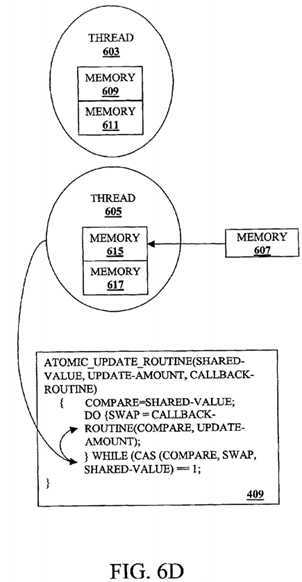
The present embodiments of the invention provide efficient, scalable, parallel?atomic?operations. A single instantiation of the present embodiments of the invention can implement efficient?atomic?operations across multiple platforms (i.e., variants of hardware architecture, operating system, threading environment, compilers and programming tools, utility software, etc.) and yet optimize performance for each individual platform. Furthermore, the present embodiments of the invention provide the ability to tailor performance and explore performance/implementation-cost trade-offs on each of multiple platforms. For example, low-level instruction sets (i.e., assembly code instructions) may be developed to support specified operators, data-types, and/or data-type sizes at a reasonable cost while still providing the ability to optimize other operators, data-types, and/or data-type sizes differently with the described embodiments of the present invention. The present embodiments of the invention provide for using low-level instruction sets to fully support a spectrum of operations, data-types, and data-type sizes on an individual platform in order to optimize performance on that platform, while still providing the ability to optimize performance separately on other platforms.
SRC=https://www.google.com.hk/patents/US6792599
Method and apparatus for an atomic operation in a parallel computing environment
标签:des style blog http color io os java ar
原文地址:http://www.cnblogs.com/coryxie/p/3978351.html